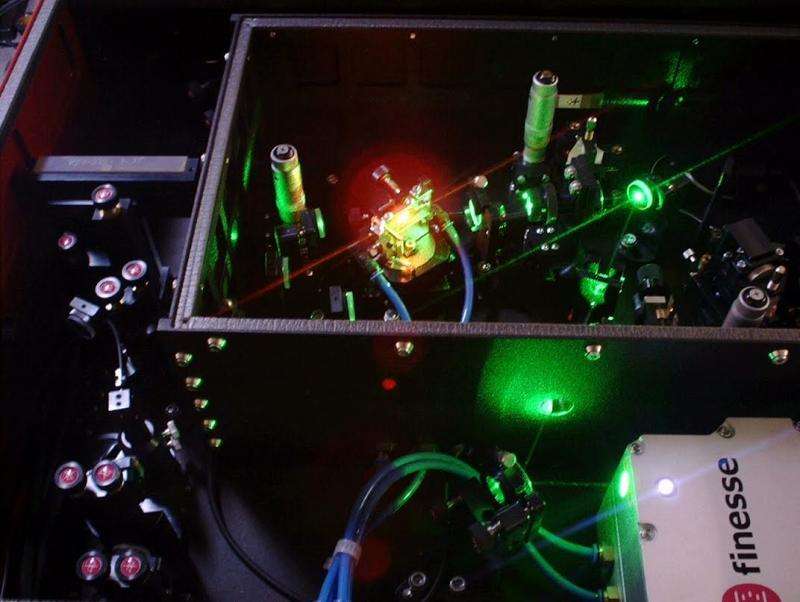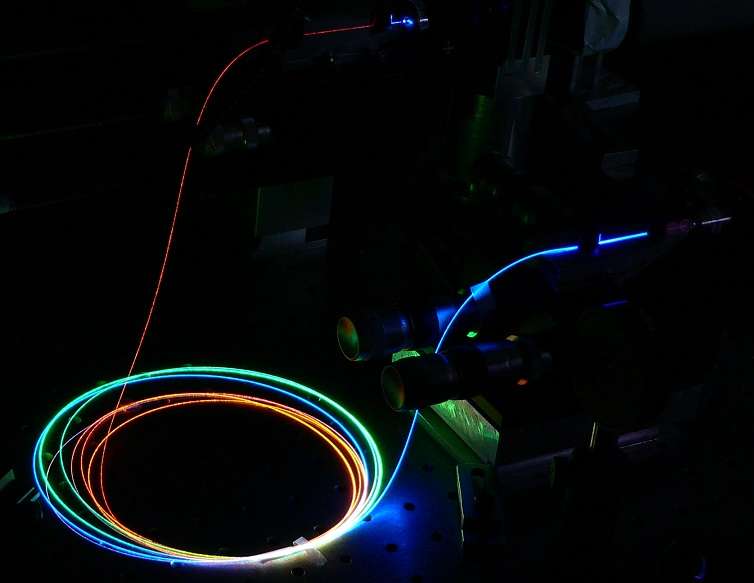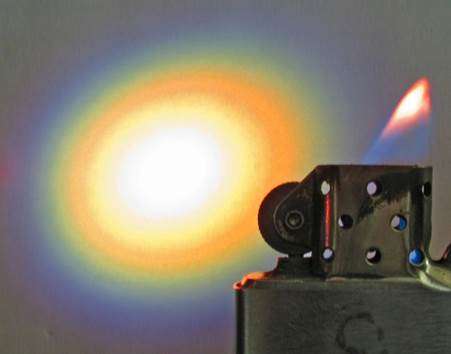Russian physicists study laser beam compressed into thin filament

A group of Russian scientists recently presented their research into the process of laser pulse filamentation—the effect produced when a laser beam propagating in air focuses into a filament. The researchers discovered how this process influences the preliminary transition of a beam passing through quartz glass, which has applications in the field of nonlinear optics.
What is nonlinear optics?
Light propagates in straight lines, and beams of light are only reflected or refracted to the side when the properties of the medium it is passing through change. This is the basis of linear optics: it is called 'linear' because the division of electric charges that occurs when light passes through a medium is linearly dependent on the intensity of the fields in the light wave itself. In other words, the stronger the electric field, the more the different charges are dispersed within the material—the material becomes polarized.
The polarization of a material should not be confused with the polarization of light. This polarization is characterised by the degree to which the positive and negative charges are dispersed in a substance, and in this way, the presence of specific directions within the electromagnetic wave within which the electric fields vibrate is called polarization.
Ordinary light is a mixture of waves having different polarizations, and lasers, as a rule, produce polarized beams, a set of similarly orientated waves.
However if the light is very strong, then its influence on materials cannot be described by these simple rules. At the microscopic level, the picture of the displacement of electric charges in substances under the influence of an electromagnetic field changes, but at normal scales, light begins to behave in strange ways. The beams, instead of dispersing in different directions and dissipating, begin to gather into narrow strands, or as optics researchers call them, filaments. Light can even make substances change color—an effect known as supercontinuum (that is, white light in which lights of different colors are mixed) and harmonic generation.

Only lasers provide a sufficiently strong light (more accurately, beam intensity) capable of producing nonlinear effects. When these light sources were first made, nonlinear optics began to develop quickly, but even today not all nonlinear optical effects are fully researched. In particular, filaments have been actively researched since the sixties, but there is still no complete theory that describes their characteristics in different conditions.
Atmospheric composition, beam intensity, wave length polarization and a multitude of other factors affect the formation of filaments. Real optical assemblies usually consist of a variety of different elements, and each of them, whether the mirror, lens, or even simple glass plates, can change the picture quite radically. In the new research, which is discussed in detail below, the scientists investigate the process of laser pulse filamentation.
The experiment and results
Nonlinear optical effects can be studied only with very large intensities. So large, in fact, that they can only be produced with powers in the gigawatt range—consequently, very short pulses are necessary for experimental research. So if a pulse with a combined energy of 2.2 millijoules is compressed to a hundred femtoseconds (10 to 13 seconds), then the power of the beam will be more than 20 gigawatts.

And if this beam is also focused into a speck with a three millimeter diameter, it produces an intensity of light an order of magnitude higher than the intensity of light near the sun's surface, which has a radiation power of about 20 gigawatts a square meter.
How does brightness differ from intensity and luminosity? Brightness is a measure of light is emitted by an object in a given direction. Luminosity describes how much light is emitted by a source in all directions. Intensity describes how much energy is carried by an electromagnetic wave in a given unit of time and in a given unit of area.
Discover the latest in science, tech, and space with over 100,000 subscribers who rely on Phys.org for daily insights. Sign up for our free newsletter and get updates on breakthroughs, innovations, and research that matter—daily or weekly.
Those dimensions are the ones used in the experiment conducted by the researchers from MSU, MIPT, and the Lebedev Institute. The experimental group, under the leadership of Andrei Ionin, head of the Laboratory of Gas Lasers, consisting of staff members Darya Mokrousova, Leonid Seleznyov, Elena Sunchugasheva and Anna Shustikova, used a Ti:sapphire pulse laser.
The beam, focused using a spherical mirror, passes through a quartz glass plate and is directed toward two ring electrodes that are held at 300 volts. When the laser pulse has ionized the air, a current passes between the electrodes and the physicists are able to assess the appearance of the plasma clusters formed under the influence of the light that has formed into filaments.
After analyzing the shape and size of the filaments thus formed, the researchers changed the quartz plate through which the light passed before it was focused. It appeared that changing the thickness of the transparent plate affected not only the length of the plasma channel, but also the distance at which it arose. By focusing the laser beam using a lens with a focal point of 230 cm in the absence of a quartz plate, the laser beam formed at a distance of 150 cm. Introducing a 4.5 mm plate caused the formation of plasma filaments to be brought nearer by 40 cm, and by increasing the thickness of the plate to 10.5 mm, the distance to the start of the plasma was reduced by almost 85 cm. In addition, the length of the plasma produced increases with an increase in the thickness of the quartz plate.
Quantitative modeling of the experiment conducted by the MSU research group revealed a strong correlation with the experiment itself. A detailed report on the behavior of the laser filaments was published by the physicists in the journal Laser Physics Letters.
Earlier, the Laboratory of Gas Lasers at Lebedev found multiple applications for such lasers, including the etching of diamonds and medical operations, as beams concentrated into fine filaments enable more precise interactions with different materials. However, in practice, real optical systems rarely consist of just one laser. They can also include mirrors, lenses and transparent windows that are used to enclose the technological space used for processing materials.
The new research has shown the even transparent plates made of quartz glass can significantly alter the laser filaments, an effect that leads to an improvement in the precision of material processing or a correction to the distance at which the power of the laser beam is delivered.
Provided by Moscow Institute of Physics and Technology





















